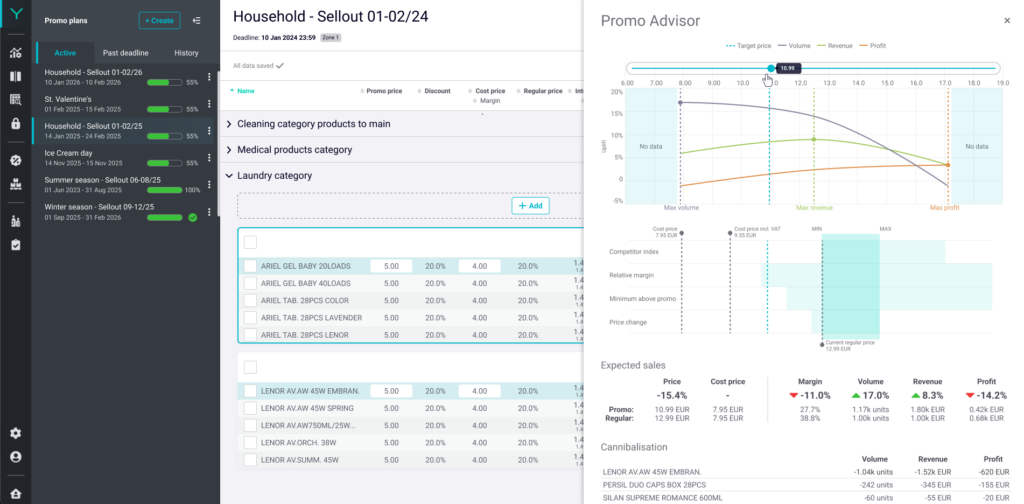Are You Aware of the EU’s Updated Consumer Protection Laws?
On the 1st of January, 2023, multiple consumer protection laws increasing the rights of shoppers purchasing goods came into effect. The Consumer Rights Act, the Act on Information on the Prices of Goods and Services, and the Unfair Market Practices Act all have changed, amongst many others.1 Retailers in EU countries where these laws are strictly applied must be in compliance with these updated directives, or face fines and legal repercussions that can even go beyond monetary penalties, depending on the severity of the case.
But, what does this really mean for retail professionals in Europe and what are the most important key takeaways applicable to any industry? In this article, we will not only relay our research on this topic from reliable legal sources, but also provide the insights we obtained from an interview we had with one of our client end-users. As such, we will share the experience of a real-life pricing manager working for a major international retail pharmacy with several pharmacies located in Poland as well as multiple e-shops across Europe, all of which must strictly comply with the Omnibus Directive. And lastly, we will briefly evaluate how Yieldigo price management software is able to help retailers stay compliant with the Omnibus Directive.
Without further delay, let’s dive into the Omnibus Directive and what you must know as a retail professional in order to ensure your business is in compliance.
What Is the Omnibus Directive?
The Omnibus Directive enforces additional transparency in prices for EU consumers. Essentially, shoppers must receive fair, full, and transparent pricing information on the products they’re offered. Promotions can only be called “promotions” if they match the Omnibus price figure of a product – otherwise, it is a failure to comply with the directive and can result in a hefty penalty. The Omnibus Price is simply the lowest price available to a consumer in the past 30 days.
The EU’s New Deal for Consumers, including the Omnibus Directive, applies to the EU and all businesses targeting EU consumers. However, the Directive does not apply to the UK or when targeting UK shoppers, meaning the EU and UK laws will likely continue to diverge on this matter going into the future.2 It is critical to note that it is the consumer targeting location that is taken into account (the question for the business being: Are we targeting EU customers?), and not necessarily the physical location of the retail business itself. For example, Tesco in the UK does not have to comply with the Omnibus Directive, but Tesco shops located in EU countries absolutely must comply with these laws as they are targeting EU consumers.
The Omnibus Directive aims to fortify consumer rights by updating EU consumer protection laws. Retailers must expect more strictly applied enforcement measures and increased transparency requirements imposed on “traders” (retailers and consumer-driven enterprises) conducting online business, particularly B2C transactions.3 However, as we will see below, the directive does not solely apply to e-commerce, but also to brick-and-mortar shop price display.
Let’s take a look at why the Omnibus Directive is being applied and updated, and how it most impacts EU retailers.
Why Is It Being Applied and Updated?
The Omnibus Directive is a response to a number of dynamic changes taking place in the digital market.4 The updates have occurred in order to further ensure a fair marketplace for consumers, as well as competition. And, it must be mentioned, that the changes in the digital market do not exclude brick-and-mortar retailers from having to fulfill the obligation to display all pricing information on the price tags of each and every product for sale. What this means is that the prices displayed on websites as well as on-site at physical stores must include three mandatory prices to list, namely:
- Regular Price – The price the consumer will pay for the product at that particular brick-and-mortar or e-shop, without promotion or discount – it’s also the price at which similar goods are regularly sold on the market.5
- Promotional Price – The price that is available to consumers for a specific product while on promotion at that particular shop (must be lower than the Omnibus Price to not be against the law). The shop must also list the previous on-sale price within the past 30 days.
- Omnibus Price – The price established by the Omnibus Directive for each item across that specific nation, territory, or region, as mandatory standard (again, promotional prices can never be higher than the Omnibus Price). It’s the lowest price available for a specific product for the past 30 days, prior to a promotional campaign.
According to the Omnibus Directive, failure to display these prices is grounds for punishment by law. The price to pay for violating the Omnibus Directive can reach 4% of the company’s total annual revenue, which for most retailers could be several millions of Euros, or 2 million Euros in cases where information on turnover is unavailable.6 And, even if an EU country does not very strictly apply these laws, retail organizations must be mindful of the consequences and abide by the regulations, as these can absolutely destroy profit margins for the grand majority of companies.
How Does the Omnibus Directive Most Impact Retailers?
According to our price manager end-user contact based in Poland, Mark (real name changed as he has asked to remain anonymous): their approach to Marketing. The Omnibus Directive primarily impacts retailers’ promotions, creating strict rules that prohibit retail shops from selling products on sale at a higher price than the Omnibus price. But also, the same promotion cannot run for more than 30 days – in other words, after 30 days, the promotion must stop and a new price for the product must be reflected.
However, as Mark told us, this has not stopped retail pros of various organizations from simply making extremely marginal price adjustments in order to keep running the almost exact same promotions, consecutively. Pricing managers can make small decimal price adjustments to continue running promotions and not be in violation of the 30-day rule – a loophole that allows retailers to continue promoting items without risk of penalty.
In the words of Mark when speaking about the Omnibus Directive overall, he says:
“It is a proper pain in the, uh… ‘backside’, but business continues as usual with no impact to profits or notable changes to promotions. It forces pricing managers and category managers to make adjustments to their strategy regarding promotional pricing (a very large part of our daily work), most especially in Poland, where these laws are very strictly enforced. The fact of the matter is that you cannot ever list items on promotion at higher prices than the Omnibus price, ever.”
According to Mark, the biggest problem for retail businesses after the Omnibus Directive was applied is having to adjust Marketing communication, compulsively. It’s also harder to navigate prices before promotions since one small error could result in a fine of millions of Euros. But, in the end, adjusting the communication of all promotions is the main factor that affects the lives of both pricing managers and B2C retail marketers, primarily.
How Does It Impact Retail Price Management Software End-Users?
If there is any upside to the Omnibus Directive, it’s that everyone is obligated to adjust their strategies equally, and these standards have been set for all – it is by no means a handicap on any one type of business or pricing professional. Yet, as Mark put it:
“For pricing managers, I feel your pain. It’s terrible, it’s horrible, I don’t like it. In my professional opinion, it didn’t protect the consumers from what it was meant to protect them from. It has not changed much, if anything, and people are still finding ways to work around this directive anyway, and that is the new job of a pricing manager – finding ways to work their promotions around these new laws. It doesn’t affect business, as much as it is just difficult to be obligated to constantly communicate all of these promotion numbers in our Marketing, while also driving sales at optimal prices as we are hired to do.”
The Omnibus Directive came to life in order to ensure companies are ethical with their prices. But, it seems not everyone feels it is achieving this desired end-result. Omnibus changed the mechanism of promotions, and consumers now have full visibility on all market prices and promotion prices. It has also effectively lowered prices on the market overall. But, as Mark said:
“We have to worry that for 30 days we will not be able to promote products or have products at promotional prices, so these prices need to be fair for others and be kept lower than the Omnibus price in order for the promotion to be legal. You can always sell for a higher price than the Omnibus price, but in this case it cannot be referred to as a promotion in any way, shape, or form. So, most of the time we must see this as not being able to truly promote items for more than 30 days, which is another hurdle for us when creating our pricing strategies.”
So, then, how does the Omnibus Directive impact daily work for pricing managers? Mark says:
“It has not changed anything for us yet, but we are about to adjust our overall strategy because of this directive very soon. There won’t be any big impact on how we approach regular prices, but for promotions we will have to set new constraints and continue our regular pricing duties with these new rules in mind. We will also maintain the same pricing time intervals as we always have, and also change them across stores in the same way we did in the past. In this sense, it is business as usual.”
Does Yieldigo Help End Users with Omnibus Directive Compliance?
The simple answer: Yes, it absolutely does (no, really, this is not a Marketing pitch, it does). Thanks to features like personalized alerts, automation of rules and limits, and the new Promo Planner module, as well as several other features that facilitate pricing strategy creation, you will have to do very little manual work to stay compliant with the Omnibus Directive, all while driving fruitful approaches to pricing.
In Yieldigo’s regular price management module, users can easily set a strict limit for regular prices, ensuring that they never go below a planned promo price figure. Once you’ve set the limit, the regular price will not cross the threshold that the end-user has established. In the case that it is already below the correct threshold, the system will suggest to raise the price. Furthermore, in regular pricing, it is possible to set a time limit for any regular price changes before a planned promotion, in order to prevent the unwanted change of a particular price.
And, in Yieldigo’s new Promo Planner module, users can have previously calculated omnibus prices available as a separate column! This allows pricing managers to clearly see the difference – mathematically speaking, the discounted amount – which helps manage promotions while always being in compliance with the Omnibus Price standard. If the Omnibus Price goes below the price of a planned promotion, users are alerted about this situation so that they can adjust the promotion immediately, sparing them headaches and the organization a fine that could reach millions of Euros.

With your Yieldigo software, you are able to remain in control of the prices you set by automating the manual price setting, which sets up the alerts via the limits and thresholds established by the end-user (usually the pricing manager). With just one competent pricing professional and Yieldigo’s software modules built for promotion planning purposes, a retail organization is able to stay in full compliance with the Omnibus Directive, with ease.
Final Thoughts on the Omnibus Directive
It seems that much like The Lord of the Rings, with Omnibus, there is just one price to rule them all. As Mark stated in his final key takeaway for retail pricing professionals:
“The most crucial point is that the customer and the Omnibus law is not looking at prices the same way that retailers are seeing them. The customer and Omnibus is looking at those prices as one entity – just one price, there is no regard for regular or promotional price. The only price that matters is the Omnibus price, making it so that regular prices and promotional prices all must revolve around that one Omnibus price standard.”
It is precisely because of these strict new legal constructs that retailers are confined to the one price standard that is set on the market by Omnibus. Yet, it can indeed be argued that despite the growing pains for the professionals in this field, the aim to make prices more fair for consumers is well-intended and may lead to a more just retail marketplace for retail organizations, as well as better and more transparent prices for consumers. Yet, it is clear that for the professionals in this field, the headache created overshadows the good it is intending to achieve. Only time will tell if the Omnibus Directive effectively creates balance for both shoppers and retail entities in the EU.
Till then, our advice to EU retail firms is to not deviate from the rules, at all cost. Use a software that helps your team stay on top of their new directive-adjusted constraints at all times – unless you are willing to pay millions of Euros for one promotion. In the end, it technically would take just one fatal mistake to destroy your margins.
You can talk to our pricing expert to learn how Yieldigo can help your team stay in compliance with the Omnibus Directive.
- TGC Corporate Lawyers, Omnibus Directive — New Obligations for Retail Industry (Online and In-Shop Sales), TGC Corporate Lawyers, 2023, (accessed 14 October 2024).
↩︎ - Termly, EU and UK Consumer Protection Laws — What do I need to know? , Termly, 2024, (accessed 14 October 2024). ↩︎
- EY Poland, The Omnibus Directive — The New Way to Enhance Protection of EU Consumers, (accessed 14 October 2024). ↩︎
- TGC Corporate Lawyers, Omnibus Directive — New Obligations for Retail Industry (Online and In-Shop Sales), TGC Corporate Lawyers, 2023, (accessed 14 October 2024). ↩︎
- Law Insider, Regular Price Definition, Law Insider, 2024, (accessed 16 October 2024). ↩︎
- E. Creaven, Tech Law, New Deal for EU Consumers- the Omnibus Directive Explained, Tech Law, 2021, (accessed 14 October 2024). ↩︎


